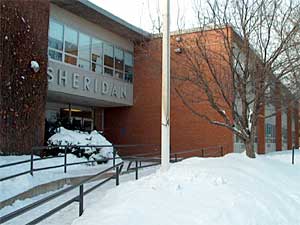A wish list for school supplies
March 15, 2004
 |
| This school year, teachers at Sheridan Elementary School in St. Paul began asking parents for basic classroom supplies. (MPR Photo/ Mark Zdechlik) |
St. Paul, Minn. — This school year at Sheridan Elementary school in east St. Paul, all of the teachers asked parents for specific materials -- and almost all of them ended up getting something.
Kathy Melander, who teaches fourth grade, asked for and received globes and boxes of Kleenex. Second grade teacher Denise Gierock also ended up with several donated items.
 | |||
"My wish included things like whiteboard erasers and markers, paper, pencils, markers, crayons -- all the things little kids use in school," Gierock said.
Music teacher Mary Holland came up with the wish list idea. Like her colleagues at Sheridan Elementary, Holland, too, had specific supplies in mind.
"I asked for pencils and notebooks," said Holland. She also asked for Kleenex.
Sheridan Elementary's wish list is a response to budget cuts. Because of declining enrollment,the school lost about $60,000 in funding this year. Rather than cutting staff, administrators and teachers decided to slash their school supply budget. They turned to parents in hopes of making up some of the difference.
 | |||
Corey Somora, who has a fourth grader in Patti Busta's class, likens the wish list to a Christmas list. Among the items Mrs. Busta wished for were reams of copier paper. Somora works at a printing company, and was able to contribute nearly a full pallet of paper.
"It was a good reaction. Actually, they were kind of amazed," Somora said. "When I brought it into the office, the lady in the office was like, 'Wow! That's a lot of paper.' I'm not sure what they're going to do with it all."
According to a recent poll of public school parents commissioned by the national PTA, more than 70 percent of parents say they're being asked to foot the bill for basic classroom supplies -- materials that once, according to those parents, were covered by public school budgets. The PTA poll also found nearly 40 percent of parents say they donate more than $100 a year to their kids' schools.
Somora says he feels fortunate he's able to contribute. He's convinced his daughter's school needs the help.
|
Do I think the school district or ... the state should be pitching in more money for these basic things? You bet. ... If we want kids to be educated and be productive members of society, they have to have the basics to come up with that.
- Jason Kuhlman, third grade teacher |
"Where else are the supplies going to come from, unless the teachers themselves buy it? You know where's it going to come from?" Somora said. "Kids get sick -- they need to blow their nose. You know, some kids don't have pencils."
But even with the donations, teachers at Sheridan Elementary -- like their colleagues at schools everywhere -- say they're spending increasing amounts of their own money to ensure they've got what they need.
Kathy Melander tallied up her spending so she could take advantage of a federal tax break. Through last year, teachers could deduct up to $250 of their out-of-pocket expenses. They can deduct more if they itemize and meet criteria to claim non-reimbursed business expenses.
The Internal Revenue Service estimates that nearly three million teachers nationwide filed the special deduction on their 2002 returns, for more than $700 million worth of out-of-pocket classroom expenses.
Melander says she spent at least $1,500 last year.
"And that's just on supplies. That's on books, that's on Kleenex, treats, taking the kids if they can't go on a field trip," said Melander. "We just don't have the monies in schools anymore, so the teachers make it up themselves."
Melander, who's taught for 30 years, says items considered extra today were once readily available on taxpayer-stocked school supply shelves. She says she wishes that were still the case. So does third grade teacher Jason Kuhlman. Kuhlman, who's relatively new to teaching, estimates he spent more than $1,000 on stocking his classroom last year.
 | |||
"Do I think the school district or ... the state should be pitching in more money for these basic things? You bet," said Kuhlman. "That's part of going to school. If we want kids to be educated and be productive members of society, they have to have the basics to come up with that."
Crystal Jackson is the mother of two Sheridan Elementary School students. She's active in the PTA, and says absent more government education spending, asking parents for help seems, so far, like a good way to get teachers and students what they need.
"Everybody does what they can, and if they can't -- that's fine. We don't pressure anybody. I don't feel pressured into doing it. It's just basically as it's stated, a wish list -- things they're wishing they can get and we just help out the best we can," said Jackson.
Given the success of Sheridan Elementary's first wish list, organizers say parents can expect a similar plea for help next fall.
Wish lists are becoming so popular that Lawson Software, based in St. Paul, recently rolled out a Web-based program that links schools in need with people and businesses interested in donating.
|
News Headlines
|
Related Subjects
|

